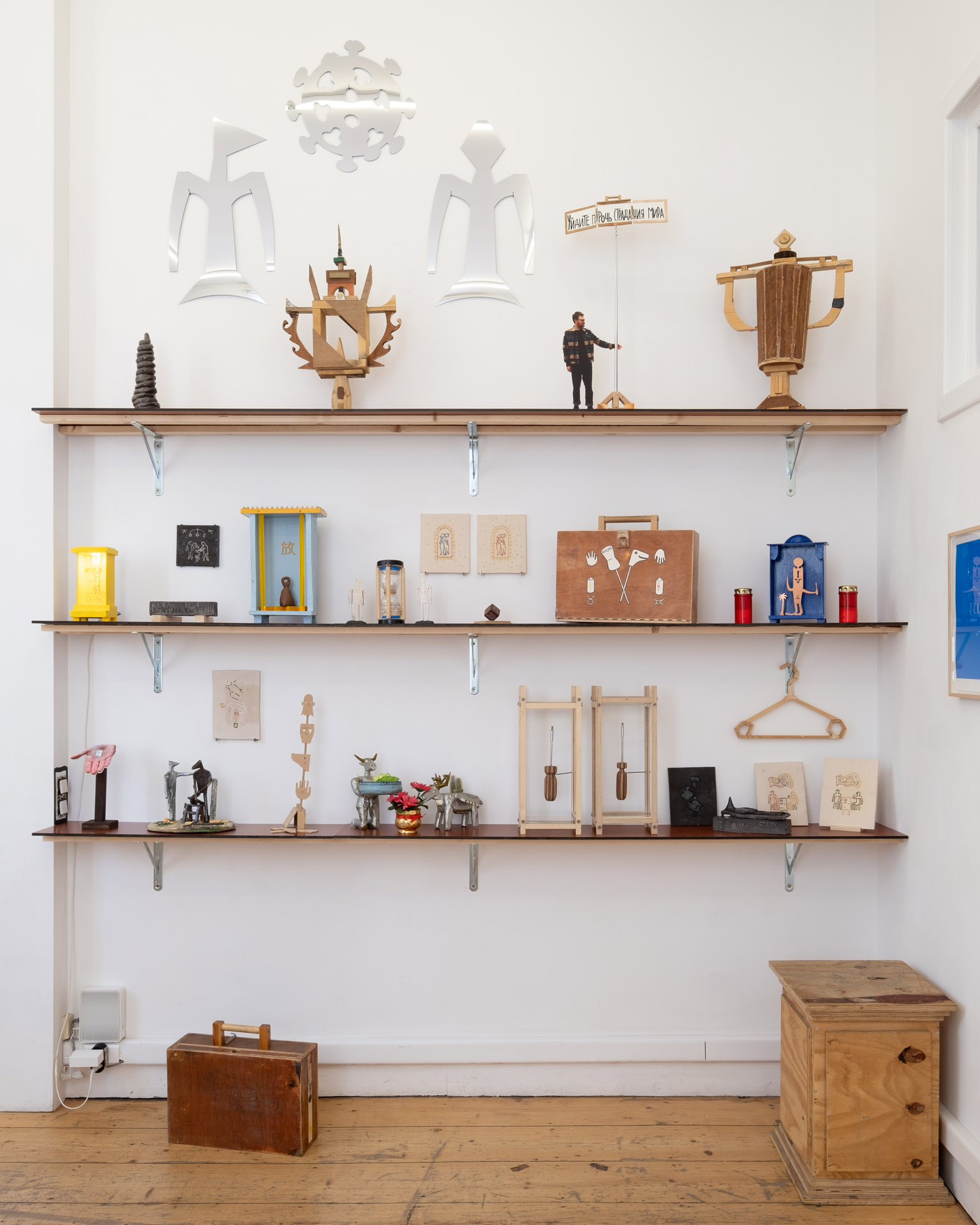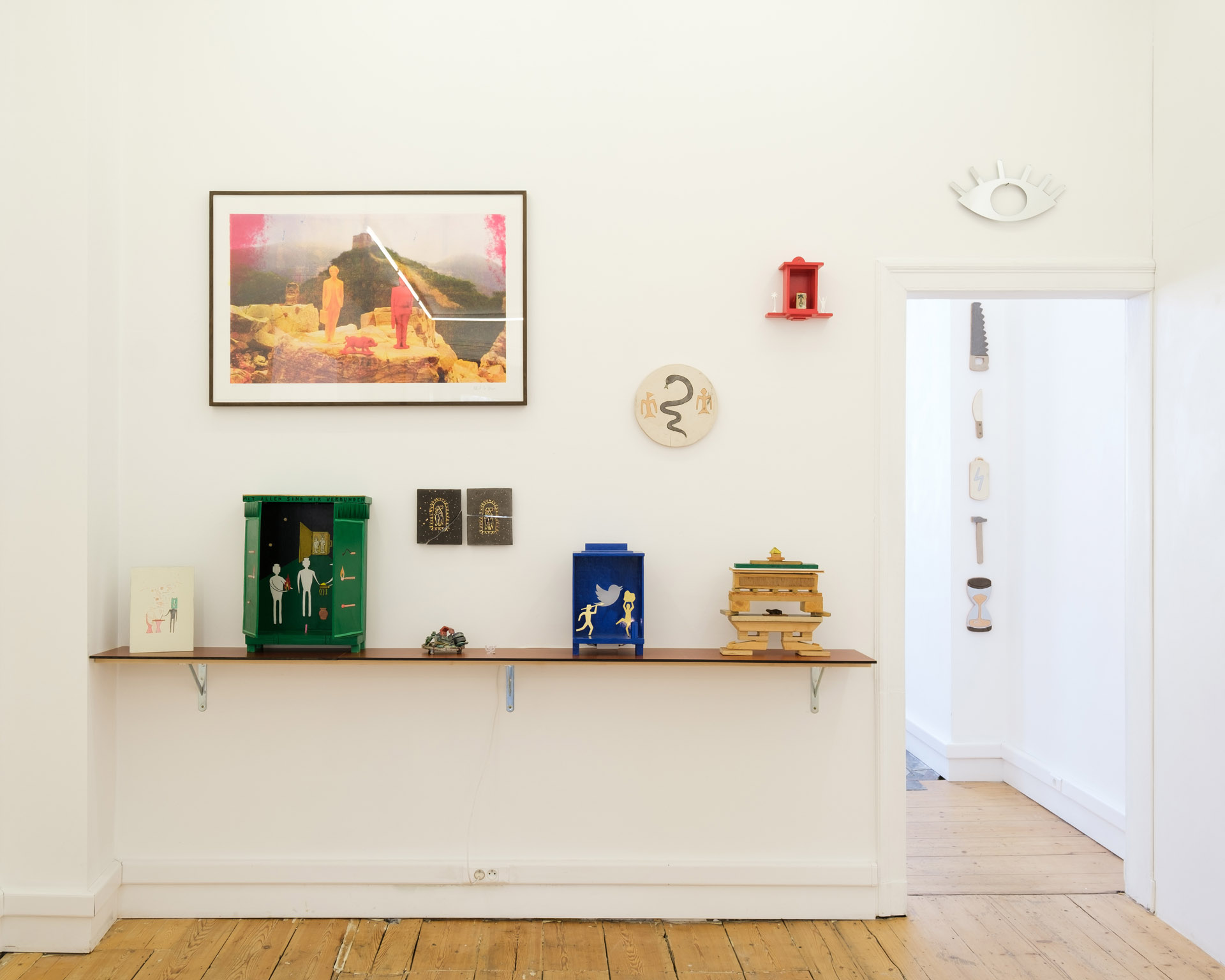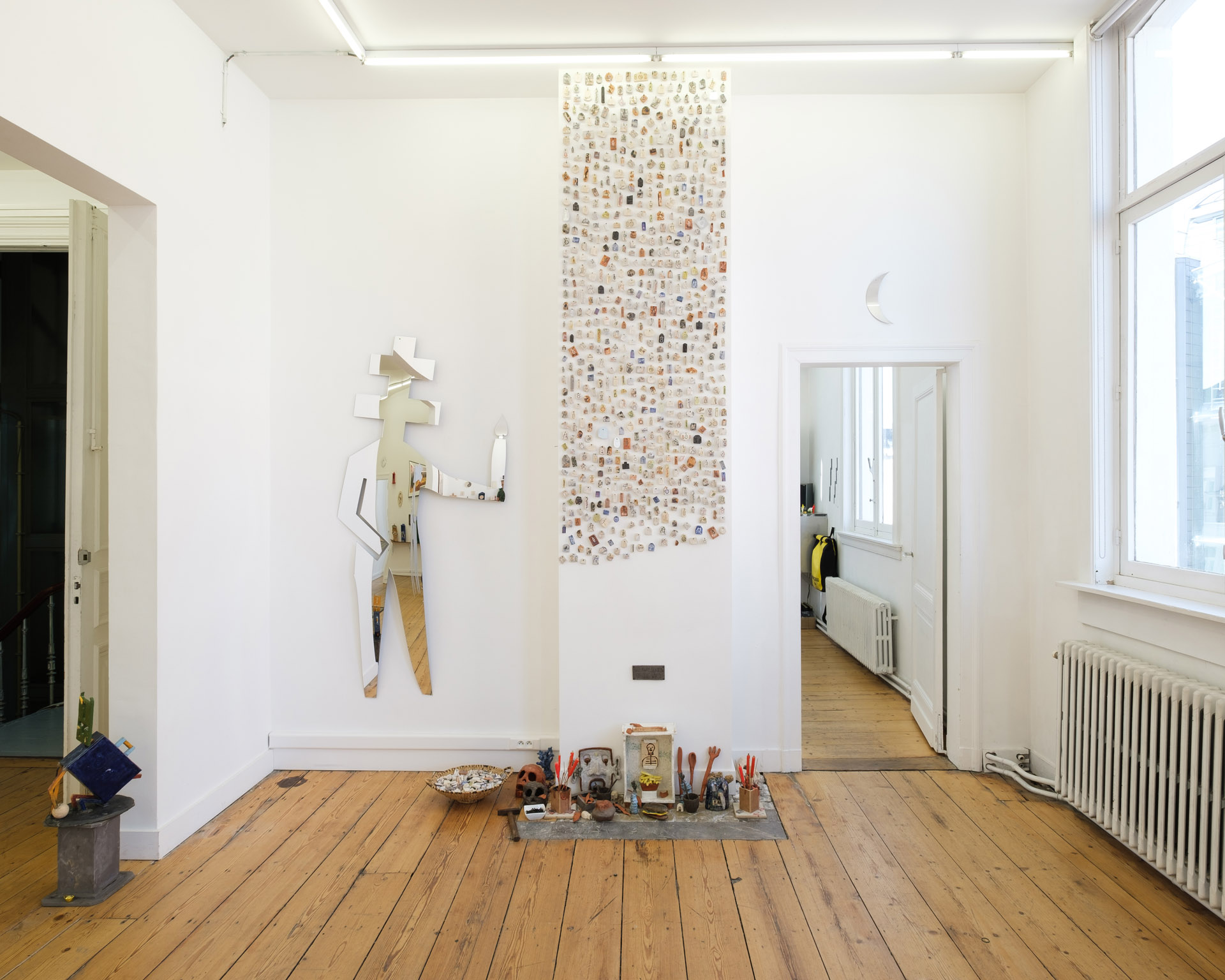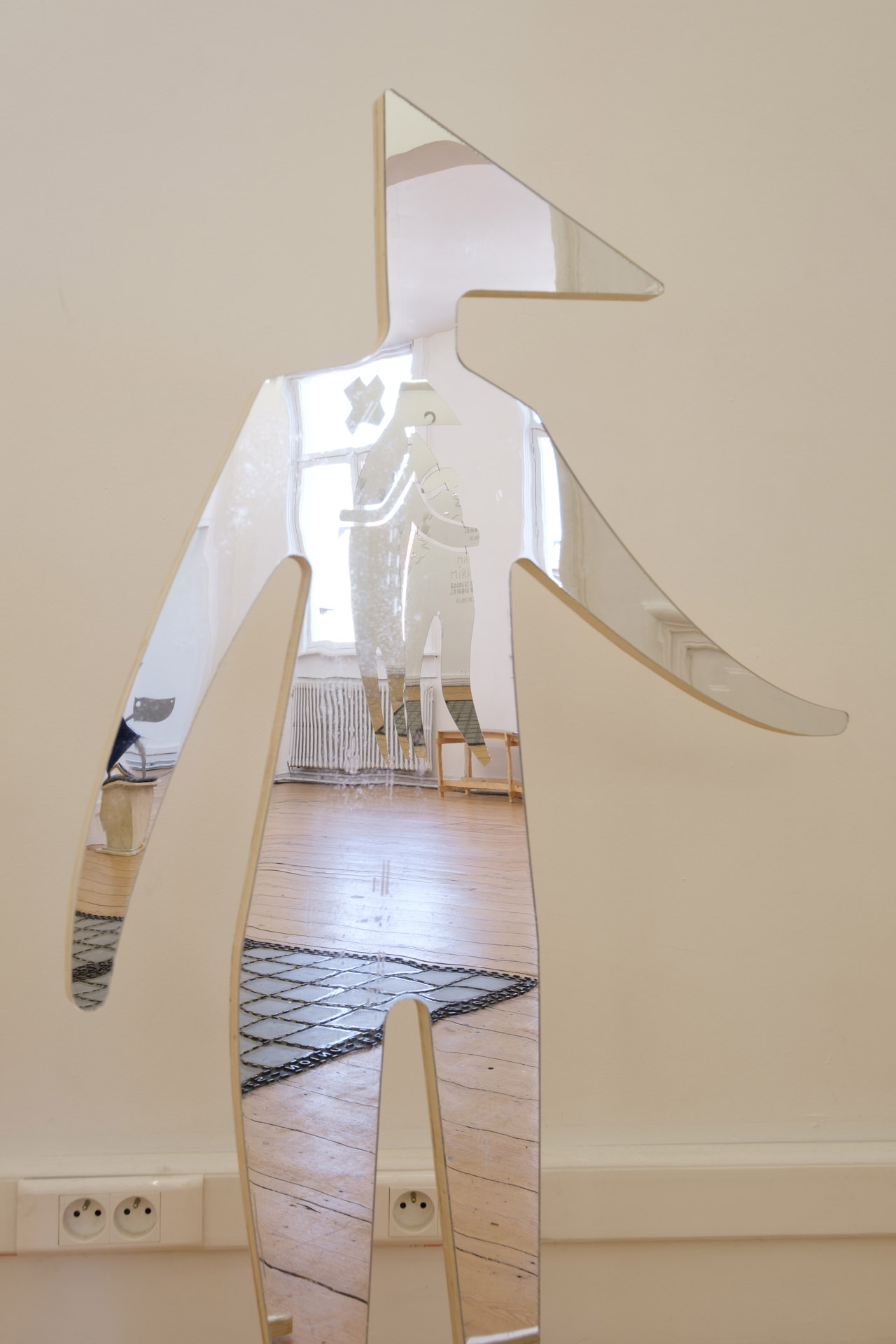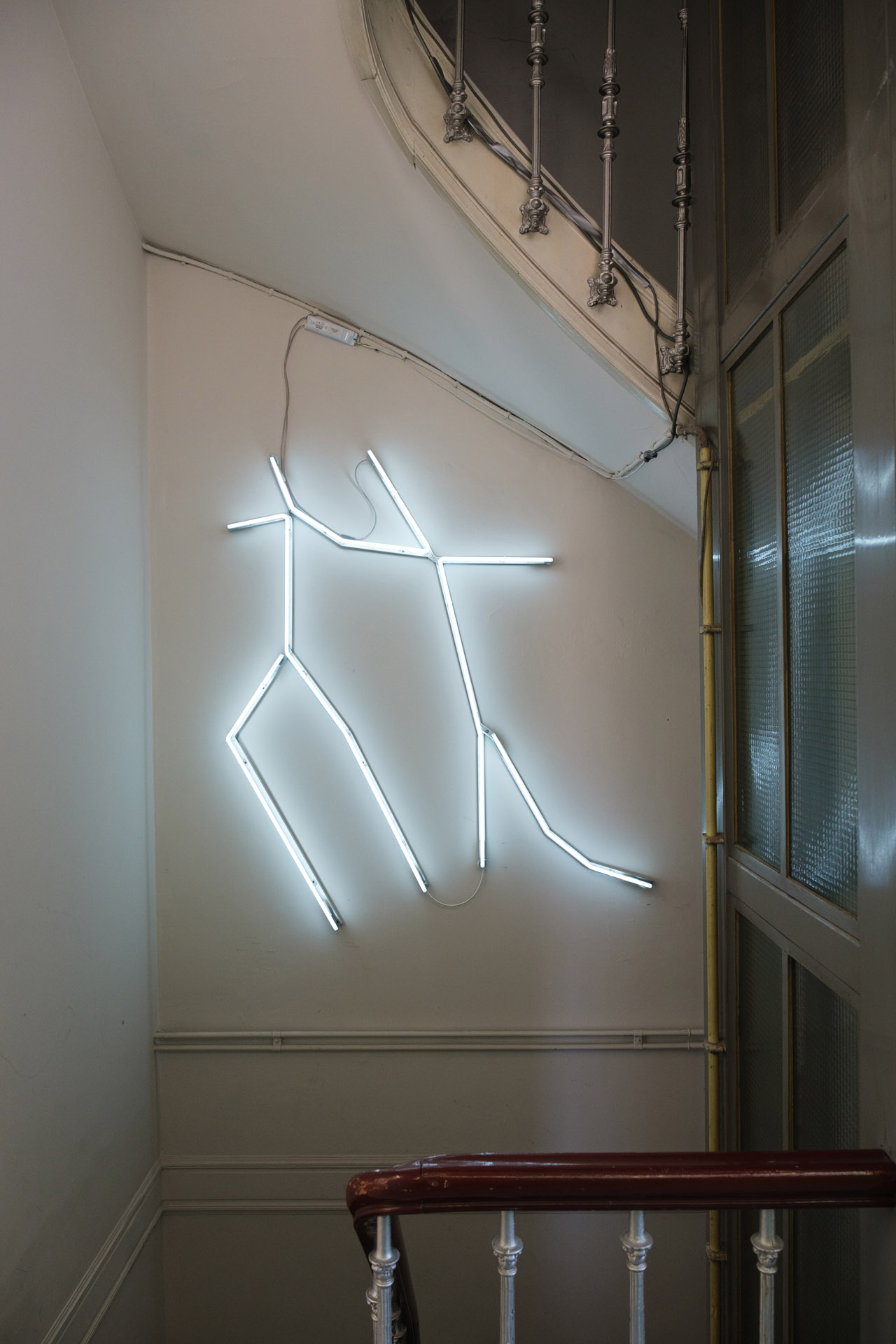Artists: Robbert & Frank Frank & Robbert
Exhibition title: Magic Mirrors
Venue: Fred & Ferry, Antwerp, Belgium
Date: September 5 – October 9, 2021
Photography: Tomas Uyttendaele / all images copyright and courtesy of the artists and Fred & Ferry, Antwerp
“And all is connected to each other
In a circle, in a hoop that never ends”
For their first solo exhibition at Fred & Ferry, artist duo Robbert & Frank Frank & Robbert (F&R R&F) take over the gallery space with mostly recent work, building on their artistic practice of the last fifteen years.
In this exhibition, smaller works of art are displayed on long shelves. There are, for example, the ceramic tiles, on which the artists record personal scenes, document previous performances or encourage new ones. These clay tablets with fine line drawings refer to the historical carriers of writing and images, but are nevertheless made by a combination of contemporary laser technology, traditional ceramic techniques and meticulous manual painting. In addition, there are also the shrines, which grew as autonomous works out of the hand luggage-sized suitcases that R&F F&R made and carried with them for their performances in public space. Traditionally, miniature shrines often serve as household sacred places where (nature) spirits are worshipped with prayers, food, flowers or precious objects. The works of F&R R&F are sometimes used as such places of worship, but they have also been decorated by children’s drawings and used as a book exchange cabinet. The implementing, or activating, of the shrines happens in complete freedom.
This openness also applies to the mirroring ensembles of large-scale shapes that rhythm the space. A mirror creates two sides. Duality always returns to R&F F&R: not least in their partnership, but also in (older) works such as the set of two personalized screws or the video work on Atari’s ping-pong video game. However, this is not an exclusive twofoldness, but a yin and yang, opposing but complementary forces that exist in relation to each other. What is projected in these reflective figures then? What is there to see? Who mirrors whom? The self the other? The child the parent? Frank Robbert? Robbert Frank? It is a magical play of perspective. A disorienting feeling of a hall of mirrors, in which the self (image) is distorted, multiplied. This re-creating of an identity is reflected in various facets of R&F F&R’s practice. They question the personal mythology of the artistic genius or gesture; they reinvent themselves in alter egos like Ox and Reindeer Head; and they are inspired by commercial (re)branding strategies, such as Coca Cola’s “You don’t buy Coke, but you open happiness” campaign.
This continuous rethinking and reforming is inherent in their associations and media: cave drawings evolve into clay tablets, characters into animals, rituals into objects. A wooden case becomes a painted shrine becomes a live performance becomes a ceramic tile becomes a charcoal wall drawing. A work of art is never finished and might only reach its full potential by being enlivened again and again in different contexts. Their process-oriented way of working is characterized by frequent repetition, retranslation; it is a relentless alchemy of elements. It is no coincidence that the snake is central to the communication image of this exhibition: a symbol of transformation, as a molting creature and as ‘ouroboros’ – the snake that bites its own tail, thus forming the eternal circle that represents cyclical nature and the unity of everything.
In the oeuvre of F&R R&F too, this unity of everything exists: the multiple movements in their work come together in their complementarity to form an idiosyncratic universe. However, the cohesion of this bigger picture often comes about through what could be called serendipity – finding some-thing unexpected and useful without consciously looking for it. R&F F&R’s interests are so broad that they can seem like separate, anecdotal aberrations. But nothing could be further away from the truth. It is precisely where the digressions intersect, without really having sought each other, that they acquire meaning. It is where the ramifications meet, as if by chance, that coherence arises.
For F&R R&F, one of those strands is linguistics. It is how in the Chinese character for “doctor” a story is embedded about bringing a stick to a wounded man in a cave. It is the study of emojis as a corporate-constructed pictographic world language – a visual language. It is exploring the power of words – pronouncing “Go away sorrow of the world” – and symbols – visually replicating the V-hand gesture.
At the same time, another strand for them is to study quantum entanglement. Trying to under-stand that quantums affect each other, no matter how far apart they are – meaning, one object says something about another. That quantums are both static particles and wave motions, depending on whether they are observed or not – in other words, that perceiving things changes the behavior of those things. That there are therefore several contradictory possibilities up to the moment of perception, and that no single perception can fully grasp reality.
It is immersing themselves in the biography of American politician Donald Rumsfeld, who play-ed a prominent role in the Iraq War as Secretary of Defense. It is contemplating that these times seem to be the pinnacle of human capability, but that there is a gaping lack of reflection, connection, imagination. That society has been disenchanted, the inexplicable banished, with no comprehensive alternative to the Great Stories. It is wondering in what kind of “clusterfuck of world proportion” you put a child on the planet. And finding meaning in all those things.
There might be a typically millennial lining to this. For R&F F&R, there is a world before and after 9/11. An analog and digital world too – this is apparent from their DIY approach to materials and techniques in combination with high-tech applications and hyperlinked thinking, the “breathing with the gills of Google”. They remain hopeful, not desperate; they are sincere, not ironic. Informed naive; pragmatically idealistic.
In line with this, the practice of F&R R&F may often seem like a funny, seemingly innocent play. But it is precisely in the pleasure of ‘trial’ and the perhaps even greater pleasure of ‘error’ that a cer-tain element of chance is allowed. And that randomness, those accidental finds of the ‘homo ludens’, provide multi-layered meanings in and between the works. There is a light-heartedness in their work, a gentle humor that lures, but which is underpinned by a serious incentive to look more closely.
In this way, it might be possible to show what their work is really all about: if the artist’s head is a sun, and that sun illuminates an object, then the work of art is the shadow. But at another time, from another position, there is another shadow. The work needs the perception of the maker and the viewer, in all its complexity and longevity. Even if that means getting supposedly sidetracked. For example, by Pocahontas. But if the artists once staged Disney icon Mickey in a sculptural installation, were inspired by an Indian custom for combustible shrines, and once used a talking tree in a theatrical performance themselves, starting an exhibition text with lyrics from “Colours of the Wind” suddenly seems less irrelevant.
-Eline Verstegen 2021











